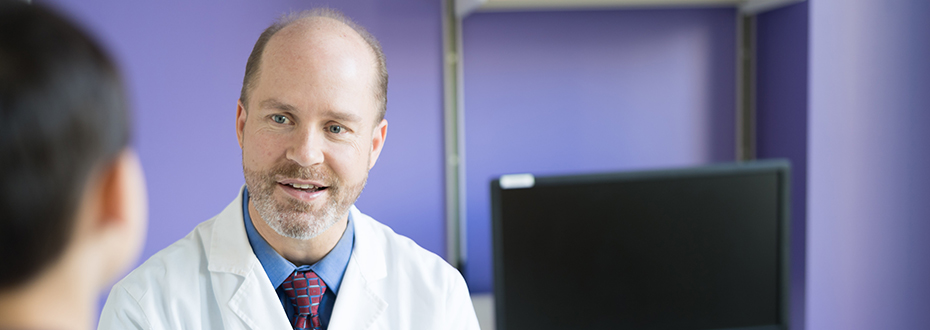Pediatric Neurogenic Bladder

OHSU Doernbecher Children’s Hospital is committed to helping your child function as normally as possible with a neurogenic bladder. This includes a range of services for children with spina bifida, a leading cause of pediatric neurogenic bladder.
You’ll find:
- Oregon’s only pediatric urology center that does complex reconstructive surgeries for neurogenic bladder, which affects bladder control.
- Comprehensive care from the state’s only spina bifida center.
- Video urodynamics, an advanced test of bladder function.
- Specialists working together.
Our excellence
Team-based care: Most children with spina bifida, a birth defect in which part of the spinal cord is exposed, have a neurogenic bladder. Our pediatric urologists and nurse practitioner are part of the Spina Bifida Program at Doernbecher’s Child Development and Rehabilitation Center. We partner with neurologists and other specialists to offer comprehensive medical and social support.
Our urologists help you and your child:
- Protect the kidneys and bladder from damage.
- Control when your child urinates.
- Become as independent as possible with toileting routines.
Expertise: Our pediatric urologists are skilled in complicated surgeries for neurogenic bladder, attracting referrals from around the region.
Parent education and support: We offer group and individual catheter training so you can help your child manage his or her bladder. We also work with your child’s school to care for your child’s needs. Our psychologists and social service specialists help you and your child cope and gain access to resources. We can also help you find spina bifida support groups.
Understanding neurogenic bladder
What is neurogenic bladder?
The urinary system’s muscles and nerves usually work together to hold in urine. With neurogenic bladder, the nerves don’t tighten or release bladder muscles normally. This can cause:
- Overactive bladder: The bladder releases urine more often than normal. It also may release it when your child is trying to hold it.
- Underactive bladder: The bladder doesn’t empty regularly, completely or at all.
Who gets neurogenic bladder?
Millions of Americans have neurogenic bladder, according to the American Urological Association. Many conditions besides spina bifida can cause neurogenic bladder. These include:
- Diabetes
- Cerebral palsy
- Brain and spinal cord defects or injuries
- Birth defects
Diagnosing neurogenic bladder
We use the latest methods to diagnose a neurogenic bladder. This includes video urodynamics testing for children. This test uses pressure testing, electronic muscle evaluation and a real-time X-ray to show how well your child’s bladder is working.
Other tests may include:
- Urine test
- Ultrasound
- MRI (magnetic resonance imaging)
- Voiding cystourethrogram, which uses dye and X-rays to examine bladder function
If your child was born with spina bifida, we will see your child regularly to check how the bladder is working. We use video urodynamic evaluation and ultrasound for these tests. Learn more about our urology tests.
Treating neurogenic bladder
Our goals in treating your child include:
- Preventing damage to your child’s bladder and kidneys
- Preventing urinary tract infections
- Enabling your child to wear underwear
Medication: Many children with spina bifida take a medicine called an anticholinergic. It helps relax the bladder so it can hold more urine. This protects the kidneys, which can be damaged if urine backs up.
Clean intermittent catheterization: A catheter (thin, flexible tube) is inserted into the bladder through the urethra, the duct that empties the bladder. The bladder is emptied, and the catheter is removed. This must be done regularly, ideally on a daily schedule.
Surgery: Surgery may be recommended if your child’s bladder doesn’t work well even with medication and catheterization. Surgery can also help if your child’s bladder doesn’t grow with your child. Our pediatric urologists are experienced in these complex surgeries. Some are done with minimally invasive techniques.
Surgery may include:
- Bladder augmentation: This uses a piece of intestine to make the bladder bigger. It can reduce the frequency of urination, prevent leaking, and keep urine from backing up into the kidneys.
- Catheterizable channel: This uses a piece of bowel to create an opening for a catheter, often through the belly button. It is typically done when a catheter can’t be placed through the urethra.
Learn more
- Urologic Care and Management, Spina Bifida Association
- Continence Management at School, Spina Bifida Association
- Spina Bifida, Centers for Disease Control and Prevention
For families
Call 503-346-0640 to:
- Request an appointment.
- Seek a second opinion.
- Ask questions.
Locations
Parking is free for patients and their visitors.
Doernbecher Children’s Hospital
700 S.W. Campus Drive
Portland, OR 97239
Map and directions
We also offer locations in Eugene and Salem.
Refer a patient
- Refer your patient to Doernbecher.
- Call 503-346-0644 to seek provider-to-provider advice.